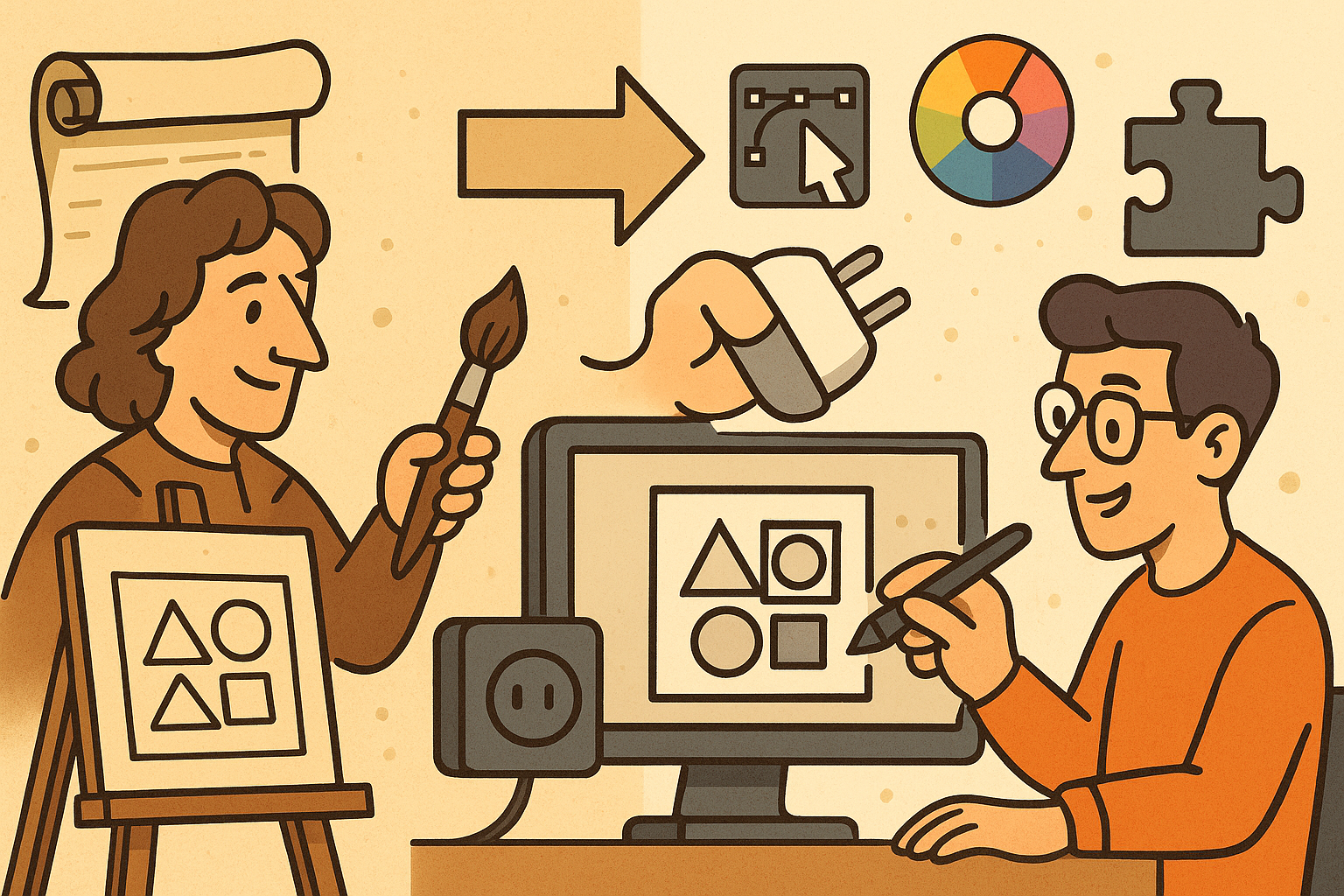Your Cart is Empty
Customer Testimonials
-
"Great customer service. The folks at Novedge were super helpful in navigating a somewhat complicated order including software upgrades and serial numbers in various stages of inactivity. They were friendly and helpful throughout the process.."
Ruben Ruckmark
"Quick & very helpful. We have been using Novedge for years and are very happy with their quick service when we need to make a purchase and excellent support resolving any issues."
Will Woodson
"Scott is the best. He reminds me about subscriptions dates, guides me in the correct direction for updates. He always responds promptly to me. He is literally the reason I continue to work with Novedge and will do so in the future."
Edward Mchugh
"Calvin Lok is “the man”. After my purchase of Sketchup 2021, he called me and provided step-by-step instructions to ease me through difficulties I was having with the setup of my new software."
Mike Borzage
Design Software History: Historical Development and Impact of Plug-ins and Extensions in Design Software Evolution
October 20, 2025 8 min read


Historical Context and Emergence of Plug-ins and Extensions
The evolution of design software has been shaped significantly by the introduction and widespread adoption of plug-ins and extensions, which played a pivotal role in advancing the capabilities of major design systems throughout the latter part of the twentieth century. In the early days of computing, design software was constrained by rigid architectural limitations that hindered the natural growth of functionality. Early programs offered only a fixed set of features, which meant that users who needed specialized or additional functions often had to resort to inventive workarounds or the purchase of entirely new software solutions. Over time, there arose a clear demand for greater flexibility and customizability, as creative and technical professionals recognized the potential for software that could be tailored to address specific design challenges. As a result, the notion of designing software as a modular ecosystem gradually evolved. This shift in mindset was significantly influenced by pioneering companies such as Autodesk, which began to explore the idea of enhancing their core products through third-party enhancements. Similarly, early design software innovators like PTC and Bentley Systems began to see that the integration of extensibility features into their digital toolkits would empower users to extend their design environments in creative and practical ways.
Foundations and Early Limitations
In a period dominated by monolithic software products, the need for creative workaround solutions emerged from the limitations inherent in these early systems. The inability to modify or expand functionalities on demand led to frustrations among professional users who required more specialized tools to address complex design problems. Historical records show that the push towards a more adaptable architecture was spurred by both internal software needs and the feedback from dedicated user communities. The gradual trend towards service-orientation and modularity allowed for the eventual birth of plug-in architectures. Noteworthy technological experiments introduced the idea of “bridging” core functionalities with supplementary modules, which laid the groundwork for what we now recognize as plug-in systems. This period marked a transformative era where the integration of extensions became synonymous with increased productivity and creative freedom, eventually establishing plug-ins as indispensable components within the design software ecosystem.
Pioneering Companies and Technologies
In parallel with this emerging philosophy, companies such as Adobe and Silicon Graphics were instrumental in pioneering early models of plug-in integration. Their investments in R&D reflected a broader industry recognition that the ability to rapidly deploy enhancements, whether developed internally or by external contributors, was crucial to meeting the evolving demands of professional design environments. The technological progress that led to more robust operating systems and the advent of object-oriented programming further enabled the practical implementation of plug-in architectures. As a result, plug-ins began to be recognized not merely as add-ons, but as core components that enabled a modular approach to design workflows. This shift in focus ultimately bestowed designers and engineers with powerful tools that could be customized to meet the specific needs of a multitude of disciplines. With plug-ins, the prevailing trend became one of democratization of digital tools, where the balance of power shifted towards the end user, fostering innovation and competitive differentiation.
Technological Advancements and Integration Strategies
The evolution of design software in recent decades has been inextricably linked with significant advancements in technology and deliberate integration strategies that paved the way for sophisticated plug-in systems. The push towards software modularity marked a paradigm shift, with architects of early design applications rethinking how functionality could be delivered in a more adaptable and user-friendly manner. The transition from monolithic systems to highly modular architectures was enabled by the emergence of open APIs and flexible scripting languages, which allowed developers to interact with core software components with unprecedented ease. These breakthroughs revolutionized the design software ecosystem by allowing third-party developers to craft extensions that seamlessly integrated with proprietary platforms, effectively broadening the spectrum of available functionalities. Strategic industry moves saw influential companies such as Dassault Systèmes and Siemens PLM Software incorporating plug-in architectures into their workflows, a decision that not only enhanced product usability but also stimulated the creation of vibrant extension communities. As developers harnessed these technological improvements, they were able to overcome many of the earlier limitations intrinsic to design tools, leading to systems that dynamically adapted to the evolving needs of users across multiple disciplines.
Modularity and Open APIs
The conceptualization of modular software design created an environment where functionalities could be added, removed, or modified without disrupting the core application. This modularity was largely made possible by open APIs that allowed for external interactions with the software. Open APIs provided a set of guidelines and protocols through which new functionalities could be integrated seamlessly, and scripting languages, such as Python and JavaScript, further empowered developers to write custom code that interfaced directly with a host application. The result was an expansive role for plug-ins that complemented the existing features of these systems. The evolution away from static software definitions towards dynamic and customizable products reflected an underlying belief in adaptability, thereby making software extensions a cornerstone in design tool evolution.
Technical Breakthroughs in Extension Development
Moreover, the 1980s and 1990s witnessed the genesis of innovative plug-in models emerging from early influential systems. Companies that had been traditional powerhouses in the CAD and design arenas started to support scripting and external plug-in architectures, providing a much-needed boost to the utility and reach of their software products. Developers could now create tools that extended beyond the original scope of the software’s built-in capabilities, enabling users to perform complex tasks and simulations that were initially unthinkable. These technological breakthroughs not only flirted with the boundaries of conventional design processes but also encouraged industry-wide experimentation with how design software could be made even more responsive to creative demands. Bullet lists, for example, became a common way of clarifying instructions and processes within these extensions:
- Enhanced modularity allowing features to be added without altering the system core.
- Utilization of scripting languages to customize operations.
- Deployment of open APIs to bridge proprietary software with third-party innovations.
Impact on Design Workflows and Industry Transformation
The integration of plug-ins and extensions has fundamentally transformed design workflows by democratizing access to enhanced functionalities and facilitating increasingly sophisticated design processes. Designers no longer remained confined to the inherent limitations of their primary software tools; instead, they were empowered to tailor their digital environments to suit unique project demands. This transformation was made possible by the rise of active and creative communities of third-party developers, each contributing innovative modules that expanded the reach of core platforms. The resulting ecosystem allowed for the aggregation of highly specialized function sets—ranging from real-time simulation enhancements to advanced product visualization capabilities. The consequential effect was a significant reduction in the learning curve and research cycles as designers could effortlessly integrate tools crafted specifically for their domains. As these vibrant communities grew, the interplay between core software manufacturers and independent plug-in creators catalyzed an industry-wide shift, making customization an integral expectation rather than a luxury capability. Consequently, operating environments became significantly more resilient, agile, and capable of responding to evolving technological demands.
Broadening the Horizons of Design Functionality
This democratization of design software has had a profound impact on professional workflows. The ability to incorporate plug-ins meant that the power to create bespoke extensions was pushed into the hands of a broader network of users, enriching the overall design process and fostering inventive approaches to problem-solving. From early integration strategies adopted by companies to the subsequent diffusion of these methods across various sectors, the trend towards customization has established plug-ins as indispensable assets. One can observe that the infusion of community-driven enhancements is responsible for several notable improvements in design methodologies. Among these, users gained access to enhanced visualization tools that expanded the conceptual horizons of digital artistry, while simulation modules allowed for the optimization of engineering parameters in near real-time. This evolution underscores the pivotal role that plug-in ecosystems have played in spawning a developmental renaissance across multiple domains of design and engineering.
Transformative Industry Influences
The influence of plug-ins extends well beyond the simple augmentation of software capabilities. In a broader context, the advent of customizable design environments disrupted traditional software development models, leading to a more open and collaborative approach among developers and users alike. The emergence of vibrant extension communities, often supported by robust documentation and open forums, transformed how professionals approached digital design challenges. This was particularly evident in advanced sectors such as architecture, automotive, and aerospace, where the iterative nature of design demanded tools that could be continually refined and extended. The following bullet points illustrate some of the structural shifts brought by plug-ins:
- Real-time simulation capabilities were notably improved through the integration of custom modules.
- Product visualization tools were enhanced by community-developed extensions, yielding earlier feedback loops and more effective presentations.
- Enhanced data interactivity and model adaptability within complex design workflows.
Conclusion and Future Outlook
Reflecting on the journey of design software, it is evident that the evolution of plug-ins and extensions has been a transformative force, redefining what is possible within digital design environments. The historical progression from rigid, monolithic software systems to versatile, highly modular applications illustrates the profound impact of early technological breakthroughs on modern practice. This metamorphosis was driven not only by the technical ingenuity of companies such as Adobe, Autodesk, and Dassault Systèmes, but also by the innovative spirit of countless developers who embraced the core philosophy of customization and collaboration. Today, plug-in architectures are recognized as essential instruments that support a diverse array of functionalities in design workflows, fostering an ecosystem where enhancements are continuously deployed to meet the changing needs of professional users. The long-term influence of these advancements can be seen in the democratization of high-powered design tools, which has ultimately empowered users across all levels of technical expertise. Looking forward, the ongoing evolution of smart technologies, including the integration of AI-enhanced tools and cloud-based collaborative platforms, indicates that the role of plug-ins is destined to grow even further.
Summarized Evolution and Continued Innovation
In summary, the historical evolution of plug-ins represents a renaissance in the way design software adapts to user needs. As industries have shifted from static systems to dynamic, modular infrastructures, the role of third-party developers has become increasingly significant. The adoption of open APIs and advanced scripting techniques has extended the inherently creative potential of traditional design tools, while enhanced plug-in ecosystems have ushered in an era characterized by remarkable flexibility and precision. The integration strategies designed by early industry pioneers have influenced generations of digital tools, ensuring that customization remains at the forefront of technological innovation. The field of design software remains in perpetual evolution, as even the most established tools now embrace a model of continuous improvement. Such ongoing development promises to incorporate emerging technologies like AI and enhanced cloud collaboration, further democratizing the design process and promoting an even more inclusive digital environment.
Future Trends and Industry Disruption
Looking ahead, several trends are poised to redefine the future landscape of plug-ins and design software integration. As technology steadily converges with the capabilities of artificial intelligence and machine learning, we expect tighter, more intuitive integrations that will enable automated customization and precision feedback loops. Cloud collaboration, on the other hand, promises to revolutionize workflow dynamics by allowing designers to share and co-develop plug-ins in real time. The anticipated focus on enhanced interoperability between diverse computing environments stands to simplify the management and deployment of extensions across large-scale projects. Bullet points summarizing these future trends include:
- Enhanced AI capabilities that enable predictive design tools and automated suggestion engines.
- Greater emphasis on cloud-driven collaboration, fostering real-time co-development and feedback cycles.
- Increased interoperability, allowing a seamless flow of extensions and plug-ins across disparate systems.
Also in Design News

Revolutionizing Design Validation with Machine Vision Technology
October 20, 2025 9 min read
Read More
Cinema 4D Tip: Optimizing Game Asset Creation for Unity in Cinema 4D
October 20, 2025 3 min read
Read More
Bluebeam Tip: Enhancing Document Reviews with Bluebeam's Highlight Tool
October 20, 2025 2 min read
Read MoreSubscribe
Sign up to get the latest on sales, new releases and more …


